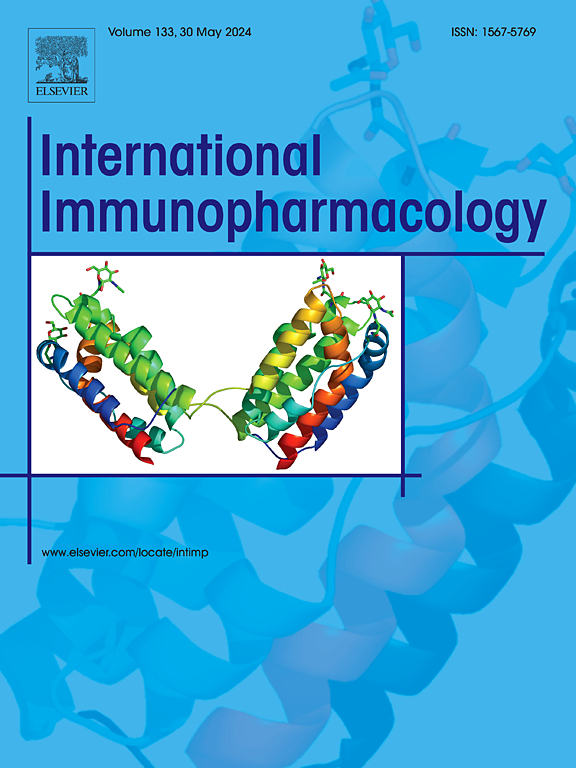NLRP3 Inflammasome-mediated pyroptosis in acute lung injury: Roles of main lung cell types and therapeutic perspectives
IF 4.8
2区 医学
Q2 IMMUNOLOGY
引用次数: 0
Abstract
The NLRP3 inflammasome plays a pivotal role in the pathogenesis of acute lung injury (ALI) by regulating pyroptosis, a highly inflammatory form of programmed cell death. NLRP3-mediated pyroptosis leads to alveolar epithelial cell injury, increased pulmonary microvascular endothelial permeability, excessive alveolar macrophage activation, and neutrophil dysfunction, collectively driving ALI progression. In addition to the classical NLRP3-dependent pathway, the non-canonical pyroptosis pathway (caspase-4/5/11) also contributes to ALI by inducing pyroptotic cell death in AECs and ECs, further amplifying NLRP3 activation through damage-associated molecular patterns (DAMP) release. Moreover, neutrophils (NE) pyroptosis exhibits dual roles in ALI, as it enhances pathogen clearance but also exacerbates excessive inflammation and tissue damage, highlighting the complexity of its regulation. Targeting the NLRP3 inflammasome and pyroptotic pathways has emerged as a promising therapeutic strategy for ALI. Various NLRP3 inhibitors (e.g., MCC950, CY-09, OLT1177) and pyroptosis inhibitors have demonstrated significant anti-inflammatory and tissue-protective effects in preclinical models. However, the clinical translation of NLRP3-targeted therapies remains challenging due to off-target effects, potential immunosuppression, lack of patient stratification strategies, and compensatory activation of alternative inflammasomes (e.g., AIM2, NLRC4). Future studies should focus on optimizing the selectivity of NLRP3 inhibitors, developing personalized therapeutic approaches, and exploring combination strategies to enhance their clinical applicability in ALI.
NLRP3炎性小体介导的急性肺损伤中的焦亡:主要肺细胞类型的作用和治疗前景
NLRP3炎性小体通过调节焦亡(程序性细胞死亡的一种高度炎症形式)在急性肺损伤(ALI)的发病机制中起关键作用。nlrp3介导的焦亡导致肺泡上皮细胞损伤、肺微血管内皮通透性增加、肺泡巨噬细胞过度活化和中性粒细胞功能障碍,共同推动ALI的进展。除了经典的NLRP3依赖途径外,非典型焦亡途径(caspase-4/5/11)也通过诱导AECs和ECs的焦亡细胞死亡,通过损伤相关分子模式(DAMP)的释放进一步放大NLRP3的激活,从而参与ALI。此外,中性粒细胞(NE)焦亡在ALI中表现出双重作用,因为它增强了病原体清除,但也加剧了过度炎症和组织损伤,突出了其调节的复杂性。靶向NLRP3炎性体和焦亡通路已成为ALI的一种有希望的治疗策略。多种NLRP3抑制剂(如MCC950、CY-09、OLT1177)和焦亡抑制剂在临床前模型中显示出显著的抗炎和组织保护作用。然而,由于脱靶效应、潜在的免疫抑制、缺乏患者分层策略以及替代炎性小体(如AIM2、NLRC4)的代偿激活,nlrp3靶向治疗的临床转化仍然具有挑战性。未来的研究应着眼于优化NLRP3抑制剂的选择性,开发个性化的治疗方法,并探索联合策略,以提高其在ALI中的临床适用性。
本文章由计算机程序翻译,如有差异,请以英文原文为准。
求助全文
约1分钟内获得全文
求助全文
来源期刊
CiteScore
8.40
自引率
3.60%
发文量
935
审稿时长
53 days
期刊介绍:
International Immunopharmacology is the primary vehicle for the publication of original research papers pertinent to the overlapping areas of immunology, pharmacology, cytokine biology, immunotherapy, immunopathology and immunotoxicology. Review articles that encompass these subjects are also welcome.
The subject material appropriate for submission includes:
• Clinical studies employing immunotherapy of any type including the use of: bacterial and chemical agents; thymic hormones, interferon, lymphokines, etc., in transplantation and diseases such as cancer, immunodeficiency, chronic infection and allergic, inflammatory or autoimmune disorders.
• Studies on the mechanisms of action of these agents for specific parameters of immune competence as well as the overall clinical state.
• Pre-clinical animal studies and in vitro studies on mechanisms of action with immunopotentiators, immunomodulators, immunoadjuvants and other pharmacological agents active on cells participating in immune or allergic responses.
• Pharmacological compounds, microbial products and toxicological agents that affect the lymphoid system, and their mechanisms of action.
• Agents that activate genes or modify transcription and translation within the immune response.
• Substances activated, generated, or released through immunologic or related pathways that are pharmacologically active.
• Production, function and regulation of cytokines and their receptors.
• Classical pharmacological studies on the effects of chemokines and bioactive factors released during immunological reactions.

 求助内容:
求助内容: 应助结果提醒方式:
应助结果提醒方式:


